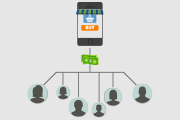Marketplaces are gaining more relevance worldwide – and in Brazil, it is no different. According to Ebit|Nielsen, marketplaces grew 13% in the country during H1 of 2019, reaching BRL 17.6 billion in revenue. Research carried out by Olist revealed online retailers sell their products in marketplaces because this helps increase their sales and profits (81.5%), reach more clients (67.9%), strengthen their brand (42%), test a new sales channel (39.2%), follow market trends (36.8%), and empower the network of store owners and brand resellers (6.7%).
Online sellers aren’t the only ones that benefit from marketplaces. In Brazil, where 38 million work informally, platforms that enable people to somehow increase their income are very popular. It is no surprise, for instance, that Brazil is Uber’s second-largest market, with over 600,000 drivers. Many have found in the app an alternative to dodging unemployment and economic crisis. Other service marketplaces, such as Helpie and Triider, are also strengthening their presence in the segment, as it helps both service providers and users.
Platforms and marketplaces like these help connect sellers, workers, freelancers, and service providers to a larger range of customers. And paying these partners and suppliers without compromising the end-customer’s experience can be challenging depending on the scenario – and yet perfectly doable.
What are the different payout scenarios?
First of all, it is important to understand the different payout scenarios for marketplaces and platforms. Many online business models can benefit from a payout solution in order to guarantee a simplified and efficient payment flow.
One-to-one
One-to-one is when one customer is charged, and one recipient is paid. It is a typical scenario for businesses such as Uber, Freelancer.com, iFood, and more.
One-to-many
Suppose the customer has accessed your platform and purchased a number of products from different stores. This is a one-to-many scenario, and marketplaces can benefit from a payout solution to pay multiple suppliers.
Many-to-many
The many-to-many payout scenario is when several are charged, and multiple recipients are paid. A good example of this model is GymPass: a platform where users pay a determined amount and have access to different partnered gyms.
Many-to-one
When many are charged, and one recipient is paid. Crowdfunding platforms, such as Kickstarter, are a good example.
How does the payment cycle work?
The payment flow can be controlled in two ways. One is by automatic cycles, based on rules defined by the platform – such as selecting a split percentage for each recipient.
The other is by an instruction – for instance after the product has been received by the customer or the service has been successfully provided.
A payout solution can offer a number of benefits. Not only does it simplify the payment flow, but it also avoids double taxation. Want to learn more about payout for platforms and marketplaces? Leave a comment below or reach out to us through our website!



